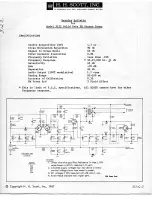
3.2.4.
Initialization
The initialization is subdivided in 3 configuration phases.
Phase 1: Tuners.
LNB settings, DiSEqC settings,
Transponder frequency and transponder search run.
Phase 2: Chosse of programmes, programme arrangement.
Multiplexing after programme filtering (Remux mode)
Transponder crossing multiplexing of FTA programmes (Cross-Multiplex mode)
LCN (Logical Channel Numbering)
Phase 3: Modulators.
Channel spacing, output channel, fine calibration and output level.
Modulation, code rate, guard interval, transmission mode.
3.3.
Initialization phase 1
During the first phase of the initialization, the tuner settings required for the scan are made and the station
scanning is carried out. The four tuners work independently from each other and after the same principle.
3.3.1.
DVB-S
Choose the tuner with the button
Tuner 1…4
.
Configure the needed settings for all tuners.
The SAT IF frequency of the transponder
is entered in the input field "
Frequency
(MHz)".
The input fields "
LOF Low Band
(MHz)"
and "
LOF High Band
(MHz)" correspond
to the oscillator frequencies of the LNB in
low and high band.
The default settings of the oscillator
frequencies are 9,750 MHz for the low
band and 10,600 MHz for the high band.
In the optional field "
Polarisation
", you
can switch from horizontal to vertical.
In the optional field "
DiSEqC
", the
DiSEqC command signals can be turned
off or set to switch a DiSEqC-enabled
multi switch on the positions 1 to 4.
If required, the operating voltage for the
LNB can be switched off via the optional
field "
LNB power supply
".
After all settings have been made, click the button
SCAN
.
A rotating circle is shown on the right side during the scanning process.
2016-10-31 | Technical changes, design modifications, errors and misprints are subject to change without prior notice.17
















































